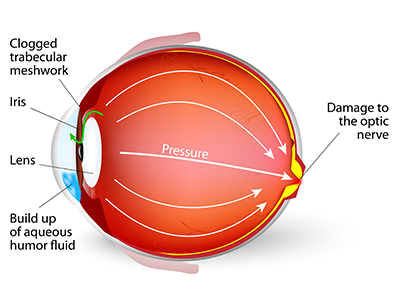 More than 2.2 million Americans age forty and older have glaucoma. Half as many may be unaware they have this potentially blinding disease because they have no symptoms.
More than 2.2 million Americans age forty and older have glaucoma. Half as many may be unaware they have this potentially blinding disease because they have no symptoms.
Glaucoma is a condition in which the optic nerve is damaged. It can be associated with elevated pressure inside the eye and can lead to vision loss.
The exact cause of primary open-angle glaucoma, the most common form of the disease, is uncertain. However, some of the other forms of glaucoma may occur along with other abnormalities of the eye.
There are usually no symptoms at first, but as the disease progresses, a person with glaucoma may notice his or her vision gradually failing with:
- Blurred vision
- Loss of peripheral vision
- Difficulty focusing on objects
- – Presence of halos around lights
Anyone can develop glaucoma. Those who are at higher risk and should have an eye exam at least every one to two years include:
- African Americans over age 40
- Individuals over age 60
- People with a family history of glaucoma
- Individuals that have experienced a serious eye injury
- People with other health conditions, such as diabetes (exam every year)
Although glaucoma cannot be cured, early detection and treatment can usually preserve vision. Dr. Jovkar can help control glaucoma by lowering intraocular pressure with eye drops, laser treatments or surgery. However, vision loss due to glaucoma cannot be restored and, if left untreated, glaucoma can lead to blindness.
Open Angle Glaucoma
Open Angle Glaucoma (OAG), occurs when there is an increase in fluid production or a decrease in fluid drainage. Over time, as the optic nerve fibers are destroyed, peripheral (side) vision is lost.
Blocked fluid flow
Aqueous humor flows out of the eye through the Trabecular Meshwork (TM), near the edge of the iris. If the TM is blocked, restricting drainage, the pressure inside the eye increases. This elevated pressure results in damage to the optic nerve and vision loss occurs.
Treatment of Open Angle Glaucoma
OAG treatment concentrates on lowering the pressure inside the eye to prevent damage to the optic nerve. The most common treatments for glaucoma have been the use of medications (in the form of eye drops or pills), laser therapy or surgery.
Medical treatments
Eye drops are commonly used to control glaucoma, hover, they can be very expensive, messy, and have unwanted side effects. Furthermore, they may need to be taken for the rest of your life. Some medications allow for faster drainage, while other medications reduce the production of aqueous humor.
Surgical treatments
If non-surgical methods fail to decrease pressure, surgery may be required to create a new drainage channel. Filtration surgeries are designed to relieve eye pressure by removing tissue, inserting implants in the eye, or a combination of both.
